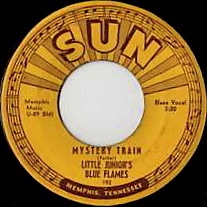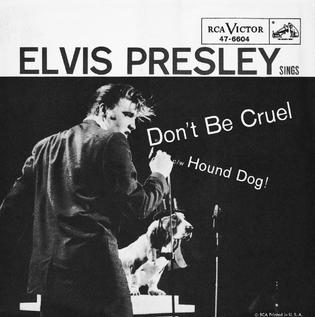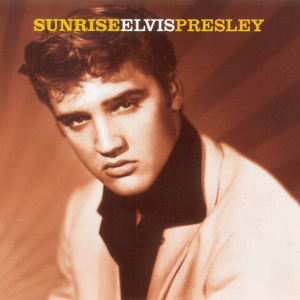
Carl Lee Perkins was an American guitarist, singer and songwriter. A rockabilly great and pioneer of rock and roll, he began his recording career at the Sun Studio, in Memphis, beginning in 1954. Among his best-known songs are "Blue Suede Shoes", "Honey Don't", "Matchbox" and "Everybody's Trying to Be My Baby".

Rockabilly is an early style of rock and roll music. It dates back to the early 1950s in the United States, especially the South. As a genre, it blends the sound of Western musical styles such as country with that of rhythm and blues, leading to what is considered "classic" rock and roll. The term "rockabilly" itself is a portmanteau of "rock" and "hillbilly"; the latter is a reference to country music that contributed strongly to the style. Other important influences on rockabilly include western swing, boogie-woogie, jump blues, and electric blues.

"Hound Dog" is a twelve-bar blues song written by Jerry Leiber and Mike Stoller. Recorded originally by Big Mama Thornton on August 13, 1952, in Los Angeles and released by Peacock Records in late February 1953, "Hound Dog" was Thornton's only hit record, selling over 500,000 copies, spending 14 weeks in the R&B charts, including seven weeks at number one. Thornton's recording of "Hound Dog" is listed as one of the Rock and Roll Hall of Fame's "500 Songs That Shaped Rock and Roll", ranked at 318 in the 2021 iteration of Rolling Stone's 500 Greatest Songs of All Time and was inducted into the Grammy Hall of Fame in February 2013.

William Patton Black Jr. was an American musician and bandleader who is noted as one of the pioneers of rock and roll. He played in Elvis Presley's early trio, The Blue Moon Boys. Black later formed Bill Black's Combo.

The Sun Sessions is a compilation album by American singer Elvis Presley, issued by RCA Records in 1976. The album contains Presley's earliest commercial recordings, made in Memphis, Tennessee for Sun Records in 1954 and 1955. RCA issued the album in the UK in 1975 under the title The Sun Collection. The album features liner notes by Roy Carr of the New Musical Express. The Sun Sessions features most of the tracks Elvis recorded for Sun Records and produced by Sam Phillips, the head of Sun Studios. The Sun Sessions reached number two on the Billboard Country Albums and number 1 on the Cashbox Country Albums charts.

"Blue Suede Shoes" is a rock and roll standard written and first recorded by American singer, songwriter and guitarist Carl Perkins in 1955. It is considered one of the first rockabilly records, incorporating elements of blues, country and pop music of the time. Perkins' original version of the song appeared on the Cashbox Best Selling Singles list for 16 weeks and spent two weeks at the number two position.

"Mystery Train" is a song written and recorded by American blues musician Junior Parker in 1953. Originally performed in the style of a Memphis blues or rhythm and blues tune, it was inspired by earlier songs and later became a popular rockabilly song, as first covered by Elvis Presley, then numerous others.

Elvis Presley is the debut studio album by American rock and roll singer Elvis Presley. It was released by RCA Victor, on March 23, 1956,. The recording sessions took place on January 10 and January 11 at the RCA Victor Studios in Nashville, Tennessee, and on January 30 and January 31 at the RCA Victor studios in New York. Additional material originated from sessions at Sun Studio in Memphis, Tennessee, on July 5, August 19 and September 10, 1954, and on July 11, 1955.
"Blue Moon of Kentucky" is a waltz written in 1945 by bluegrass musician Bill Monroe and recorded by his band, the Blue Grass Boys. The song has since been recorded by many artists, including Elvis Presley, Paul McCartney. The song is the official bluegrass song of Kentucky.

"Don't Be Cruel" is a song that was recorded by Elvis Presley and written by Otis Blackwell in 1956. It was inducted into the Grammy Hall of Fame in 2002. In 2004, it was listed #197 in Rolling Stone's list of 500 Greatest Songs of All Time.
"Cry! Cry! Cry!" is the debut single by singer-songwriter Johnny Cash. The song was originally released in 1955 and reached number 14 on the Best Sellers charts.

"Good Rocking Tonight" is a jump blues song originally released in 1947 by its writer, Roy Brown and was covered by many recording artists. The song includes the memorable refrain, "Well I heard the news, there's good rocking tonight!" The song anticipated elements of rock and roll music.

Sunrise is a two-disc compilation of Elvis Presley's studio recordings at Sun Studio from 1953 to 1955, released in 1999, RCA 67675-2. This set features all of the surviving master recordings made by Presley and his accompanists, Scotty Moore and Bill Black, occasionally augmented by other musicians, prior to his arrival on RCA Records in 1956.

Elvis at Sun is a compact disc compilation of Elvis Presley's studio recordings at Sun Studio from 1954 to 1955, released in June 2004, BMG Heritage 61205. This set features master recordings made by Presley and his accompanists, Scotty Moore and Bill Black, occasionally augmented by other musicians, prior to his arrival on RCA Records in early 1956.
"Baby Let's Play House" is a song written and originally recorded by Arthur Gunter in 1954 on the Excello Records label, and covered by Elvis Presley the following year on Sun Records. A line from the song was borrowed by John Lennon for his Beatles song "Run for Your Life", released on Rubber Soul in 1965.
"Tryin' to Get to You" is a song written by R&B singer songwriters Rose Marie McCoy and Charles Singleton. It was originally recorded by the Washington DC vocal group The Eagles in 1954 and released in mid-1954 on Mercury Records 70391. The format of the title on The Eagles’ record was “Tryin’ to Get to You”, with an apostrophe.

Beyond the Sun is the eleventh studio album by Chris Isaak, released through Vanguard Records on October 18, 2011. It is a collection of songs recorded by Sun Records artists Elvis Presley, Johnny Cash, Roy Orbison, Carl Perkins and Jerry Lee Lewis. Some of the songs were originally released on Sun Records. The record itself was recorded at Sun Studio, Memphis, Tennessee and the cover photograph was taken by Sheryl Louis outside the studio on Union Avenue.

"Birth of Rock and Roll" is a 1986 song written by Carl Perkins and Greg Perkins. The song was featured on the Class of '55 album which included performances with Johnny Cash, Roy Orbison, and Jerry Lee Lewis. "Birth of Rock and Roll" was released as a 7" single with a picture sleeve, 885 760–7, on the Smash/America label copyrighted by PolyGram Records produced by Chips Moman. The single reached No. 31 on the Billboard country chart and No. 44 on the Canadian country chart in 1986. The B side was "Rock and Roll (Fais-Do-Do)" which featured Johnny Cash, Jerry Lee Lewis, and Roy Orbison. The theme of the song “Birth of Rock and Roll" is about how "Memphis gave birth to rock and roll" in the 1950s at Sun Records. A video of the song was also made featuring Carl Perkins, Jerry Lee Lewis, and Ronnie Wood of The Rolling Stones as they drove to the historic Sun studios in Memphis, Tennessee in a white Cadillac convertible.
"I'm Left, You're Right, She's Gone" is a song written by Bill Taylor and Stan Kesler, and originally recorded by Elvis Presley for Sun Records.













